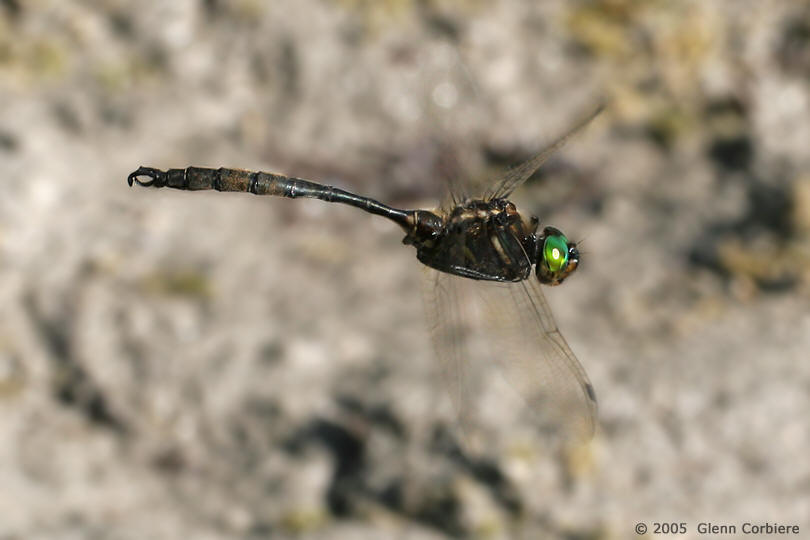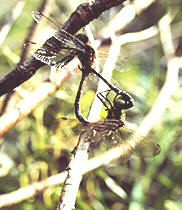Somatochlora hineana
Lifecycle

Courtesy of Glenn Corbiere ©2005 Image not to be used without permission by the
artist
The lifecycle of a Hine's emerald dragonfly begins when the
female lays eggs, called ovipositing, into shallow waters. S. hineana
larvae are aquatic and approximately 25mm in length and light to dark brown when
mature. The larvae body is densely covered in setae (hair). The
larval stage is the longest lasting stage of the lifecycle, ranging from 2-4
years. Larvae and possibly the eggs as well are able to overwinter.
As the larvae start to mature, metamorphosis begins. When mature, the
larvae crawls out of the water and attaches itself to a support (i.e. plant
stem). The larvae then exits its exoskeleton, leaving behind what is
called an exuviae (Cashatt). The new dragonfly (in its teneral stage) then extends
its wings and waits to dry out. The juvenile dragonfly is extremely
vulnerable at this time. Once dry, the juvenile begins to vibrate its
wings and takes to the air in flight. A juvenile S. hineana has
brown or reddish eyes which begin to turn green after a few days. As
dragonflies age, not only do their eyes turn to emerald green, but the yellow
thoracic stripes begin to fade to a cream colored, or even white in some old
males; and the amber-tinted wings start to fade, becoming localized to the
exoskeleton, leaving behind what is
called an exuviae (Cashatt). The new dragonfly (in its teneral stage) then extends
its wings and waits to dry out. The juvenile dragonfly is extremely
vulnerable at this time. Once dry, the juvenile begins to vibrate its
wings and takes to the air in flight. A juvenile S. hineana has
brown or reddish eyes which begin to turn green after a few days. As
dragonflies age, not only do their eyes turn to emerald green, but the yellow
thoracic stripes begin to fade to a cream colored, or even white in some old
males; and the amber-tinted wings start to fade, becoming localized to the
 base
of the wings (Burton). Dragonfly adults typically live 5-6 weeks (Cashatt). When in
their adult stage, these dragonflies are mainly concerned with food and mating.
Adult males spend a few days eating after emerging from their exuviae before
moving back to their breeding grounds (Burton). Once
returned, they establish and defend breeding territories by hovering and darting
over shallow pools of water. As females approach, males pursue and mate
with them. The claspers of the male are used to grab onto the head of the
female. The male is then able to connect the second segment of his
abdomen, which is where his sperm have been localized, to the eighth segment of
the female's abdomen, which is where her eggs and ovary are located. Then
the sperm is transferred to the female and the female leaves to oviposit her
eggs (Cashatt).
base
of the wings (Burton). Dragonfly adults typically live 5-6 weeks (Cashatt). When in
their adult stage, these dragonflies are mainly concerned with food and mating.
Adult males spend a few days eating after emerging from their exuviae before
moving back to their breeding grounds (Burton). Once
returned, they establish and defend breeding territories by hovering and darting
over shallow pools of water. As females approach, males pursue and mate
with them. The claspers of the male are used to grab onto the head of the
female. The male is then able to connect the second segment of his
abdomen, which is where his sperm have been localized, to the eighth segment of
the female's abdomen, which is where her eggs and ovary are located. Then
the sperm is transferred to the female and the female leaves to oviposit her
eggs (Cashatt).